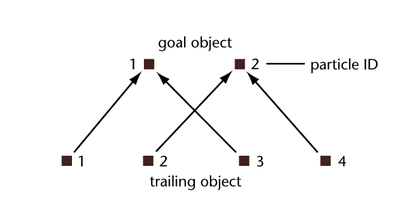Particle objects are useful as goal objects because of the many techniques available for animating particle motion. You can’t add a goal to individual particles of the particle object, but you can control how influential each particle is on the trailing object (see Set goal weights on a per-particle basis).
If the goal is a particle object, its particles attract the particles of the trailing object one for one as the animation plays. If particles in the objects do not die, the trailing particles follow goal particles based on the creation order. For example, the particle created first in the trailing object follows the particle created first in the goal object. The particle created last in the trailing object follows the particle created last in the goal object.
If particles in either object die, the preceding scheme no longer applies. You can no longer visually predict which trailing particle will follow a particular goal particle.
If the trailing particle object has more particles than the goal object and particles don’t die in either object, the extra particles follow the first-created particles of the goal.
For instance, suppose you create a goal object with two particles and a trailing object with four particles. The four particles would move toward the two particles like this:
